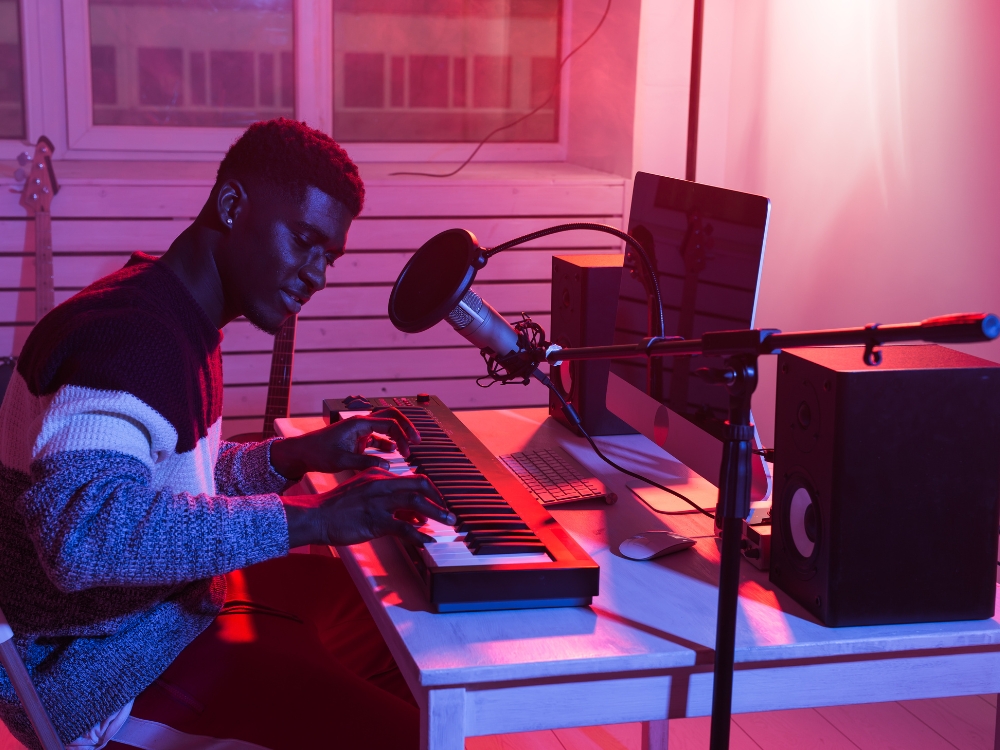Affiliate Disclaimer
As an Amazon Associate, we earn from qualifying purchases.
Welcome to our discussion on how to choose the right size studio monitors for your room. If you’re a music producer, audio engineer, or musician, then you know the importance of having accurate and detailed sound reproduction in your home studio. Studio monitors are the backbone of any home studio setup, and they provide the necessary clarity and detail required for producing high-quality music, mixing, and mastering.
Did you know that the global music industry is valued at over $21 billion? This industry includes not only the production and distribution of music but also the equipment used in music production, such as studio monitors. With so much money being invested in the music industry, it’s no wonder that many aspiring musicians and producers are setting up home studios to create their music.
However, setting up a home studio requires a lot of careful consideration, especially when it comes to selecting the right size studio monitors. In fact, choosing the wrong size monitors can result in inaccurate sound reproduction, which can ultimately lead to poorly mixed and mastered tracks. This is why it’s essential to choose the right size studio monitors for your room.
We’ll explore the various factors to consider when choosing the right size studio monitors, including room size, listening distance, budget, music genre, and room acoustics. We’ll also provide you with practical tips and advice on how to select the appropriate size monitors for your home studio, so you can achieve accurate and detailed sound reproduction and produce high-quality music, mixing, and mastering.
Table of Contents
ToggleThe importance of room size in choosing the right size studio monitors
Room size is a critical factor to consider when choosing the right size studio monitors. This is because the size of the room can affect the sound quality produced by your studio monitors. In general, larger rooms require larger studio monitors to produce accurate and detailed sound. Conversely, smaller rooms can cause bass buildup and create a muddy or boomy sound.
One way to determine the appropriate size of studio monitors for your room is to measure the size of your studio space. For smaller rooms, 5-inch or 6-inch monitors will suffice, while medium-sized rooms can benefit from 7-inch or 8-inch monitors. Large rooms, on the other hand, may require 10-inch or larger monitors.
Another crucial factor to consider is the shape of your room. Square or rectangular rooms can cause standing waves, which can lead to bass buildup and uneven sound distribution. In such cases, it may be necessary to install bass traps or other acoustic treatments to help reduce these issues.
How listening distance affects the size of monitors you need
The listening distance between your studio monitors and your ears is another essential factor to consider when choosing the right size studio monitors. This is because the closer you are to your monitors, the smaller the size you can get away with, and vice versa.
For instance, if you sit close to your monitors, then smaller monitors will be adequate. However, if you sit further away from your monitors, larger monitors may be necessary to achieve the same sound quality. This is because larger monitors can move more air and produce more bass.
It’s also worth noting that the ideal listening distance is generally considered to be about one meter. This distance helps to ensure a more accurate and balanced sound distribution.
Budget-friendly options for studio monitors
Studio monitors can be quite expensive, especially if you’re looking for high-quality monitors. However, there are budget-friendly options available that can still provide decent sound quality.
One option is to go for smaller-sized monitors, as they are typically less expensive than larger monitors. Another option is to opt for studio monitors with fewer features. For instance, monitors without built-in amplifiers tend to be more affordable.
It’s important to note that while budget-friendly options can still provide decent sound quality, they may not be suitable for all types of music production or mixing. Therefore, it’s essential to assess your needs and budget before making a decision.
How your music genre affects the size of studio monitors you need
The music genre you produce can also impact the size of the studio monitors you need. This is because different music genres have different sound characteristics, and the size of the studio monitors can affect how well those characteristics are reproduced.
For instance, if you produce music that relies heavily on bass, such as hip-hop or electronic dance music, larger monitors may be necessary to reproduce accurate and detailed bass. However, if you produce acoustic music that relies more on mid-range frequencies, such as folk or classical music, then smaller monitors may suffice.
It’s important to note that the type of music you produce is not the only factor to consider when choosing the right size studio monitors. It’s also crucial to consider other factors, such as room size, listening distance, and acoustics.
The role of room acoustics in choosing the right size studio monitors
Room acoustics play a critical role in the sound quality of your studio monitors. The size and shape of your room, as well as the materials used in construction, can affect the sound produced by your monitors.
To optimize the sound quality of your studio monitors, it’s essential to consider room acoustics. There are several ways to improve room acoustics, including installing acoustic panels, bass traps, and diffusers. These treatments can help to reduce unwanted reflections and reverberations in your room, leading to a more accurate and balanced sound distribution.
It’s also worth noting that room acoustics can influence the size of studio monitors you need. For instance, if your room has poor acoustics, you may need to opt for larger monitors to produce accurate and detailed sound. On the other hand, if your room has excellent acoustics, you may be able to get away with smaller monitors.
The impact of studio monitor placement on sound quality
Studio monitor placement is another critical factor to consider when choosing the right size studio monitors. The placement of your monitors can affect the sound quality and accuracy produced by your monitors.
To ensure optimal sound quality, it’s essential to position your monitors correctly. Ideally, your monitors should be placed at ear level and angled toward your listening position. This will help to ensure that the sound is directed toward your ears and that you can hear the full frequency range of your mix.
It’s also important to consider the distance between your monitors and the walls of your room. If your monitors are placed too close to the walls, it can cause reflections and affect the accuracy of the sound. Therefore, it’s recommended to place your monitors at least a foot or two away from the walls.
Consider the quality of your audio interface
The quality of your audio interface can also impact the sound quality produced by your studio monitors. A low-quality audio interface can limit the accuracy and detail of your sound, even if you have high-quality monitors.
When selecting an audio interface, it’s important to consider the quality of the components used, such as the converters and preamps. Higher-quality components will generally result in more accurate and detailed sound.
It’s also worth noting that some audio interfaces are specifically designed to work with certain sizes of studio monitors. Therefore, it’s essential to consider the compatibility of your audio interface with the size of your monitors.
In conclusion,
Choosing the right size studio monitors requires careful consideration of several factors, including room size, listening distance, budget, music genre, room acoustics, monitor placement, and the quality of your audio interface. By considering these factors, you can ensure that you choose the appropriate size monitors that will provide accurate and detailed sound for your music production or mixing needs.
Enhance Your Monitoring Experience: Must-Have Accessories for Studio Monitors
Automate Your Studio Monitor Shutdowns and Save Energy
Reduce Vibrations and Improve Sound Quality
Protect Your Monitors from Vibrations and Enhance Performance
Keep Your Studio Environment Clean and Free of Dust and Allergens
Ensure Accurate and Consistent Sound Across Different Playback Systems






